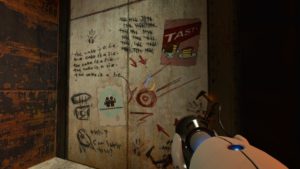The idea of “show, don’t tell” is important to visual media. To have a story play out in front of a viewer not only gives them a clearer vision of the world, but also allows for the director to add in little elements that reward the viewer should they find them.
In video games, this idea can be utilized with great potential. Although games have a central plot or concept, delving into the secrets of a world often yields new information that changes the story or overall atmosphere the player and their party reside in. These can range from incoherent ramblings on a wall, to odd placements of common household items, to a crash site that hints to the past. These inclusions allow players a brief moment of thought as they piece together the image on screen and place this new understanding into the world at large.
A fantastic example is Valve’s own “Portal” series. “Portal,” on the surface, has a simple enough premise: you are a subject conducting a series of tests. There’s no dialogue or human contact, but even in isolation players can start to learn about the world.
Chambers will start with a well-lit sign. These signs mainly indicate the progress players have made, but astute observers can pick up on symbols hinting at the level’s contents and hazards. Understanding these symbols doesn’t just prepare you for the puzzle—they also help you understand how supervisors communicate and the language they use. This information may not add to the core gameplay experience, but it allows for a better understanding of an environment and increases immersion.
It’s behind the laboratory walls where the lore truly shines. While at first everything is normal, players may find themselves accidentally wandering into a hidden room. In these moments, players see strange ramblings on a wall. But as they find more through exploration, they have the opportunity to piece together a separate story of their own.
 A simple technique like this adds layers to a story, where a story moves from simple and lighthearted to ominous and foreboding. It makes players ask questions and recall bits of dialogue and the details they’ve spotted to gain a new understanding of the game. No voice over the intercom told the player everything is not as it seems. Instead, it was the ramblings of a madman, found in side areas, who had players question the strange labs they explore.
A simple technique like this adds layers to a story, where a story moves from simple and lighthearted to ominous and foreboding. It makes players ask questions and recall bits of dialogue and the details they’ve spotted to gain a new understanding of the game. No voice over the intercom told the player everything is not as it seems. Instead, it was the ramblings of a madman, found in side areas, who had players question the strange labs they explore.
A game’s environment is a useful tool for “showing” rather than “telling” a story, and it must be utilized properly to add depth. When players understand they can find lore by sidetracking, they become absorbed into the world as they are rewarded with knowledge. These environmental details may sometimes add nothing to the story, but when focused and detailed, can completely change how one understands the plot. When used correctly, players may even reflect on this information outside of the game— staying absorbed in the world as they piece together their own discoveries and discussing with their friends the meaning of their findings.
These bits of information should not be told to the player. Instead, they should be treated like discoveries waiting to happen.



Leave a Reply